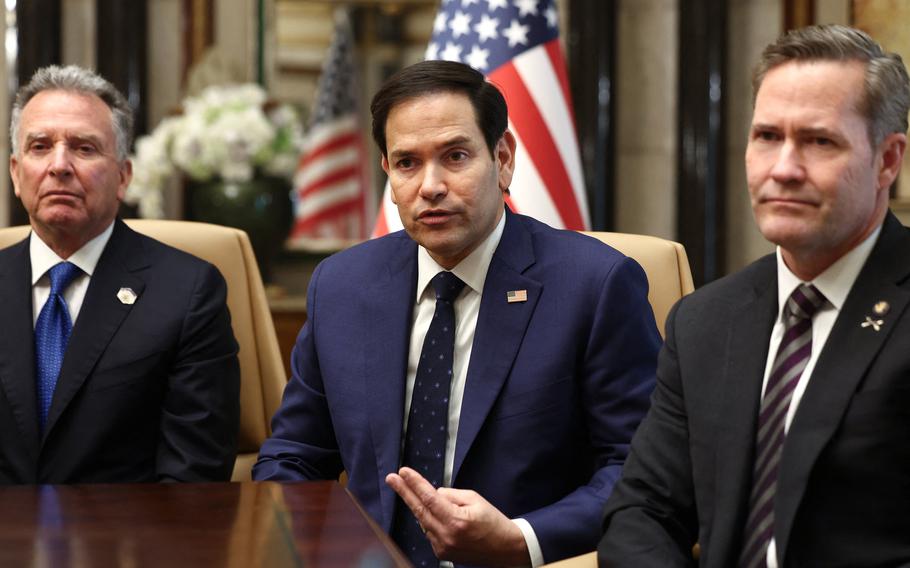
U.S. Secretary of State Marco Rubio, center, U.S. National Security Adviser Mike Waltz (now U.N. ambassador), right, and U.S. Middle East envoy Steve Witkoff attend an interview after meeting with Russian Foreign Minister Sergei Lavrov and Russian President Vladimir Putin's foreign policy adviser Yuri Ushakov, at Diriyah Palace, in Riyadh, Saudi Arabia, on Feb. 18, 2025. (Evelyn Hockstein/Pool/AFP/Getty Images via TNS)
WASHINGTON (Tribune News Service) — President Donald Trump recently suggested he’d rather his administration didn’t use the Signal messaging app. A recent photo suggests his team isn’t getting the message.
A photograph taken by Reuters shows National Security Adviser Mike Waltz — who was later removed from the job and nominated as U.S. ambassador to the U.N. — checking chats on what appeared to be a modified version of Signal at a meeting attended by Trump and his Cabinet on Wednesday.
A closeup of the photo of Waltz’s phone reveals records of chats and calls with Secretary of State Marco Rubio, Trump envoy Steve Witkoff and Tulsi Gabbard, the director of national intelligence. A partial text from Rubio reads “... there is time.” One from Vice President JD Vance can also be seen, reading “I have confirmation from my counterpart it’s turned off. He is going to be here...”
Officials’ use of Signal provoked an uproar in March after the Atlantic revealed that Waltz had inadvertently added its editor, Jeffrey Goldberg, to a Signal group chat to discuss plans to attack Houthi rebels in Yemen. That episode was believed to have played a role in Trump’s decision to remove Waltz as his top national-security aide and nominate him to the UN role.
In the aftermath of the controversy, Trump himself suggested officials shouldn’t be using the app and said he preferred in-person conversations about sensitive topics.
“I think we learned — maybe don’t use Signal, OK?” Trump told Goldberg and other Atlantic reporters in an interview published on Monday, before the latest photo was taken.
Still, the use of Signal, a secure messaging app, has been routine among government officials of both administrations for several years. The White House played down the issue when asked about the photo on Thursday.
“As we have said many times, Signal is an approved app for government use and is loaded on government phones,” deputy White House spokeswoman Anna Kelly said. The State Department didn’t respond to a request for comment.
The officials’ use of Signal is also the subject of a lawsuit brought by the liberal-leaning advocacy group American Oversight. The nonprofit alleges participants in the chat on Houthi war plans violated records-preservation laws by sending messages that are designed to disappear.
The latest photo suggests that Trump’s team may have absorbed accusations that earlier Signal messages were set to disappear in violation of federal records-retention laws. At the bottom of Waltz’s screen a message reads “Verify your TM SGNL PIN.” TM SGNL, otherwise known as Signal Capture, is an app that captures and retains mobile content, according to its developer, TeleMessage.
Experts said administration officials’ use of even a modified version of Signal was still worrisome, and backing up the messages added new concerns.
Software that allows the archival of the messages “brings in the question of how these messages are transmitted and stored and if those are ultimately vulnerable to retrieval from an adversarial state actor,” said Mark Trott, a retired FBI agent with Concentric, a private-security company based in Kirkland, Washington.
Andrew Martin contributed to this report.
©2025 Bloomberg L.P.
Visit bloomberg.com.
Distributed by Tribune Content Agency, LLC.